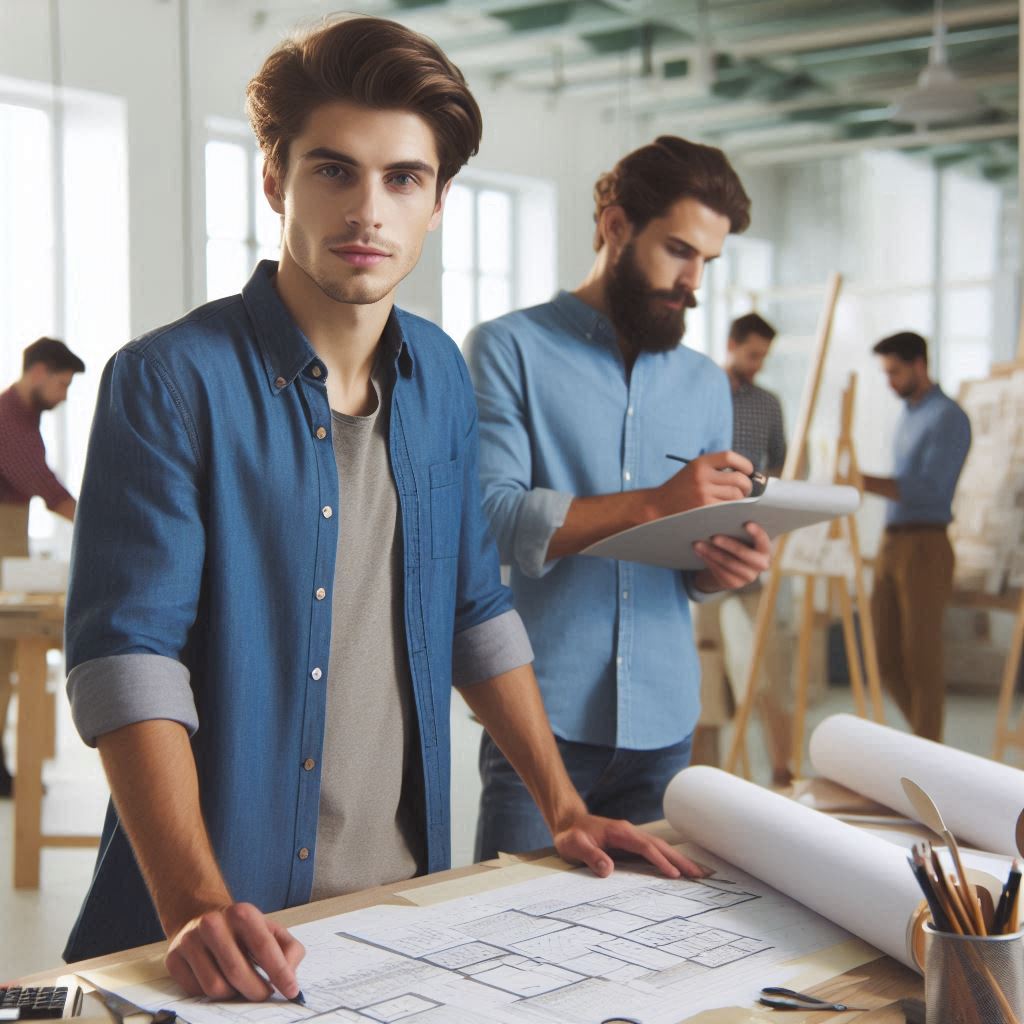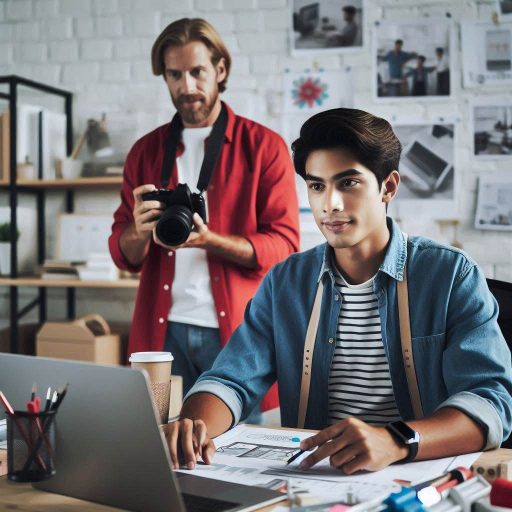Introduction
Exhibition design plays a crucial role in creating engaging spaces for events and displays.
Designers must consider aesthetics, functionality, and audience interaction.
A well-designed exhibition captures attention and communicates messages effectively.
It serves as a platform for brands to showcase products and ideas.
Today, exhibition designers face numerous challenges in their work.
Rapid technological advancements require constant adaptation.
Designers must integrate new tools and media while ensuring a seamless visitor experience.
Sustainability has become a significant focus, pushing designers to use eco-friendly materials and practices.
Budget constraints also impact creativity, forcing designers to find innovative solutions within limited resources.
Additionally, designers must address diverse audience expectations.
Creating inclusive experiences that resonate with various demographics is essential.
Navigating complex logistical issues, such as space limitations and installation timelines, adds another layer of difficulty.
Furthermore, the rise of virtual and hybrid events complicates traditional exhibition design strategies.
Overall, the evolving landscape of exhibition design demands flexibility and creativity.
Designers must embrace challenges to create memorable experiences.
By staying informed and adapting to changes, they can continue to thrive in this dynamic field.
Limited Budgets
Impact of Limited Budgets on Exhibition Design
Limited budgets present significant challenges for exhibition designers today.
Financial constraints can restrict creativity and limit design options.
Designers must find innovative ways to maximize impact while minimizing costs.
The pressure to stay within budget often leads to tough decisions.
A reduced budget affects every aspect of exhibition design.
Designers may need to compromise on materials, technologies, and even the scale of their displays.
For instance, using high-quality, durable materials may become unfeasible.
Instead, they might opt for less expensive, yet effective, alternatives.
These choices can impact the overall visual appeal and functionality of the exhibition.
Cost-Effective Design Solutions
One effective solution to working within a tight budget is to prioritize key elements.
Designers should focus on aspects that will have the most significant impact on visitors.
For example, they can invest in captivating graphics or interactive displays while simplifying the booth structure.
This strategy can help create an engaging experience without overspending.
Another cost-effective solution is to utilize modular design.
Modular components allow for flexibility in layouts and configurations.
Designers can reconfigure these elements for different exhibitions, reducing the need for new materials each time.
This approach not only saves money but also reduces waste.
Tips for Budget Management
Effective budget management is crucial for exhibition designers.
Creating a detailed budget plan at the start helps track expenses.
Designers should allocate funds wisely, identifying essential versus non-essential items.
They can also consider a phased approach, allowing for adjustments as the project progresses.
Regular communication with stakeholders is vital.
Keeping everyone informed about budget limitations helps manage expectations.
Designers should present cost-effective alternatives that align with the overall vision.
This transparency fosters collaboration and ensures everyone remains on the same page.
Finally, leveraging technology can enhance budget management.
Using design software enables precise planning and visualization.
Designers can simulate different layouts and material costs before making final decisions.
This approach minimizes surprises during execution and helps avoid unnecessary expenses.
In review, limited budgets challenge exhibition designers but also inspire creativity.
By focusing on key elements, utilizing modular designs, collaborating with sponsors, and effectively managing budgets, designers can overcome financial constraints.
Embracing these strategies can lead to impactful exhibitions that leave lasting impressions while remaining financially viable.
Fast-Paced Technological Advancements
Exhibition designers face numerous challenges today, with fast-paced technological advancements being one of the most significant.
Technology has transformed the way exhibitions are created and experienced.
Designers now incorporate digital elements, interactive displays, and virtual reality into their projects.
This evolution enhances visitor engagement and offers immersive experiences.
However, the rapid pace of technological change poses unique challenges for designers.
How Technology Has Affected Exhibition Design
Technology has reshaped exhibition design in many ways.
Designers now use digital tools to enhance storytelling and showcase products.
Interactive elements like touchscreens and augmented reality create more engaging experiences.
These features allow visitors to interact with displays in meaningful ways.
As a result, exhibitions become more memorable and impactful.
This shift toward technology-driven design can attract larger audiences and enhance visitor satisfaction.
The challenge of Keeping Up with New Technologies
Keeping up with new technologies is a daunting task for designers.
They must continuously learn about emerging trends and tools.
Many designers attend workshops, conferences, and online courses to stay informed.
This commitment requires time and resources, which can be scarce.
The sheer volume of options can overwhelm designers, making it difficult to select the right tools.
The rapid pace of change adds pressure to stay relevant in a competitive market.
Moreover, the learning curve associated with new technologies can slow down project timelines.
Designers must balance innovation with practical execution.
They need to consider how quickly they can integrate new tools into their design process.
This juggling act can lead to stress and uncertainty in meeting deadlines.
Some designers may struggle to convince clients to invest in the latest technologies, as clients often seek budget-friendly solutions.
Benefits of Incorporating Technology into Exhibitions
Despite these challenges, incorporating technology into exhibitions offers significant benefits.
Interactive elements can capture visitors’ attention and keep them engaged.
For example, touchscreens and augmented reality experiences can provide valuable information and create memorable interactions.
This enhances the overall exhibition experience and fosters deeper connections with audiences.
Moreover, technology can streamline the design process.
Designers can use advanced software to create 3D models and simulations.
These tools help visualize concepts and make adjustments before construction begins.
This efficiency can reduce costs and save time in the long run.
Incorporating technology also allows for data collection and analysis.
Exhibition designers can gather visitor feedback and behavior metrics.
This information helps them understand what works and what doesn’t.
Designers can then refine future exhibitions based on this data, leading to improved outcomes.
Ultimately, while fast-paced technological advancements present challenges for exhibition designers, they also offer opportunities for innovation.
Staying informed and adaptable is crucial in this ever-evolving landscape.
By embracing technology, designers can enhance visitor experiences and create impactful exhibitions that resonate with audiences.
Balancing the demands of innovation with practical execution will set successful designers apart in today’s competitive environment.
Read: How to Create Memorable Characters: Pro Tips
Space Constraints
Exhibition designers often confront significant challenges related to space constraints in venues.
Many exhibition venues have limited square footage, making design work more complex.
Designers must create impactful displays within tight areas while still meeting client objectives.
The first step in addressing space constraints is understanding the venue layout.
Address the Issue of Limited Space in Exhibition Venues
Thoroughly assess the available space before initiating the design process.
This assessment includes noting entry and exit points, power sources, and wall placements.
Analyzing these elements helps designers identify potential obstacles early.
It also allows them to plan effectively for visitor flow and engagement.
Provide Strategies for Maximizing Space Utilization
To maximize space utilization, designers should consider several strategies.
One effective approach is to use vertical space creatively.
Designers can incorporate tall structures or suspended elements to draw the eye upward.
This technique not only saves floor space but also adds visual interest to the exhibit.
Another strategy involves modular design elements.
Modular components allow for flexible arrangements, adapting to different spaces as needed.
This adaptability can also facilitate easier transportation and assembly, saving time and labor costs.
Furthermore, using multifunctional furniture can optimize space.
For example, benches can double as display surfaces, enhancing functionality without cluttering the area.
Designers should also prioritize open sightlines to create a more inviting atmosphere.
An open layout encourages exploration and engagement while making the space feel larger.
Incorporating transparent materials, such as glass or acrylic, can enhance this effect.
These materials help maintain sightlines and allow for better visibility across the exhibit.
Importance of Clear Communication with Venue Managers
Clear communication with venue managers is crucial for successful exhibition design.
Designers must work closely with managers to understand venue limitations.
This collaboration ensures that designers respect regulations and optimize layout according to the space’s characteristics.
Establishing a positive relationship with venue staff fosters cooperation and efficiency.
Regular check-ins during the planning process help clarify expectations.
Designers should solicit feedback from venue managers on potential challenges and solutions.
This proactive communication enables designers to adjust their plans based on real-time input.
Basically, addressing space constraints requires a blend of creativity and collaboration.
By utilizing vertical space and modular designs, exhibition designers can maximize limited areas.
Effective communication with venue managers further enhances the design process, ensuring success.
In an ever-evolving exhibition landscape, tackling space constraints head-on will lead to more innovative and engaging experiences.
The ability to adapt and thrive within these challenges sets exceptional designers apart in the industry.
Read: Ceramic Art Exhibitions to Visit in 2024
Changing Audience Expectations
In the world of exhibition design, audience expectations have transformed significantly over the years.
Attendees now seek more than static displays and passive experiences.
They demand engaging and interactive environments that capture their attention.
This shift poses a unique challenge for designers aiming to create compelling exhibitions.
How Audience Expectations Have Evolved Over Time
Historically, exhibitions relied heavily on traditional elements.
Static displays and informational panels dominated the landscape.
However, as technology has advanced, so too have audience expectations.
Today‘s visitors want immersive experiences that resonate with their interests and emotions.
They yearn for interaction, personalization, and a sense of involvement.
This evolution requires exhibition designers to rethink their approaches and strategies.
The Challenge of Engaging Modern Audiences
Engaging modern audiences presents several challenges.
First, designers must compete with a plethora of entertainment options.
Audiences are now accustomed to high-quality, interactive experiences from various media sources.
They expect exhibitions to provide similar levels of engagement and excitement.
Second, attention spans have decreased, making it crucial to capture interest quickly.
Designers face the task of delivering impactful content in a shorter timeframe.
Third, the diversity of audiences demands a more tailored approach.
Designers must consider varying preferences, backgrounds, and experiences to create inclusive environments.
Suggestions for Creating Interactive and Immersive Experiences
To address these challenges, designers should focus on creating interactive and immersive experiences.
One effective strategy involves incorporating technology into exhibitions.
Virtual reality (VR) and augmented reality (AR) can enhance visitor engagement.
These tools allow attendees to interact with exhibits in novel ways.
By integrating technology, designers can transport audiences to different times and places, creating memorable experiences.
Another suggestion is to embrace storytelling.
Designers can weave narratives into their exhibitions to captivate audiences.
By presenting information within a compelling story, visitors can connect emotionally with the content.
This approach makes the experience more relatable and memorable.
Additionally, fostering collaboration among different disciplines can yield innovative results.
Designers should work closely with artists, technologists, and educators.
This collaboration can lead to the creation of unique experiences that engage diverse audiences.
Interdisciplinary teams can brainstorm and implement creative solutions that appeal to various visitor segments.
Finally, feedback loops are essential in refining exhibitions.
Designers should actively seek input from attendees before, during, and after events.
Understanding audience perspectives helps in identifying areas for improvement.
This practice fosters a culture of continuous learning and adaptation.
In essence, changing audience expectations challenge exhibition designers today.
By understanding these expectations and implementing engaging strategies, designers can create memorable experiences.
Embracing technology, storytelling, collaboration, and feedback can significantly enhance audience engagement.
The key lies in being adaptable and responsive to the evolving needs of modern audiences.
ir audience in today’s dynamic and competitive landscape.
Read: Character Design Trends: What‘s Hot in 2024?

Sustainability Concerns
The Growing Emphasis on Sustainability in Exhibition Design
Sustainability has become a critical focus in exhibition design.
As public awareness of environmental issues grows, designers must adapt.
They face increasing pressure to implement sustainable practices in their projects.
This shift aims to reduce waste and minimize environmental impact.
Transform Your Career Today
Unlock a personalized career strategy that drives real results. Get tailored advice and a roadmap designed just for you.
Start NowThe Challenges of Incorporating Sustainable Practices
One significant challenge is sourcing sustainable materials.
Many traditional materials contribute to environmental degradation.
Designers often struggle to find eco-friendly alternatives that meet aesthetic and functional requirements.
For instance, plastic is commonly used but creates long-lasting waste.
Finding biodegradable or recycled materials can be difficult, yet it is essential.
Another challenge is the logistics of sustainable design.
Shipping eco-friendly materials can be costly and complex.
Transportation emissions from materials can negate some sustainability efforts.
Designers must consider local sourcing to mitigate these impacts.
However, this can limit available options, creating a balancing act between sustainability and design.
Designing for reusability poses additional challenges.
Many exhibitions are temporary, with structures dismantled after use.
Creating modular and reusable components can be difficult but necessary for sustainability.
Designers must think creatively to ensure installations can be repurposed or reused in future projects.
This requires collaboration with stakeholders and a commitment to innovative design solutions.
Budget constraints often hinder sustainable practices in exhibition design.
Companies may prioritize cost over eco-friendliness, limiting designers’ options.
Sustainable materials and practices can carry higher initial costs.
However, designers can advocate for the long-term benefits of sustainability.
Highlighting cost savings from reusable materials can help shift perspectives.
Examples of Eco-Friendly Design Solutions
Despite these challenges, many designers are finding innovative eco-friendly solutions.
For instance, some exhibitions use sustainable materials like bamboo or reclaimed wood.
These materials not only reduce waste but also enhance the design’s aesthetic appeal.
Designers also incorporate energy-efficient lighting to lower power consumption during exhibitions.
Another example is the use of digital technology to minimize physical materials.
Virtual reality and augmented reality can create immersive experiences without relying on traditional displays.
This approach reduces waste while providing engaging content for visitors.
Exhibition designers are increasingly exploring modular designs.
These structures can be easily assembled, disassembled, and reused.
They allow for flexibility while minimizing environmental impact.
Designers can create exhibitions that adapt to different spaces while adhering to sustainability goals.
In general, sustainability concerns significantly impact exhibition designers today.
While challenges exist in sourcing materials, logistics, and budgeting, innovative solutions are emerging.
By embracing eco-friendly practices, designers can create impactful exhibitions that resonate with environmentally conscious audiences.
The commitment to sustainability not only enhances design but also contributes to a healthier planet.
Read: How to Price Your Ceramic Artwork
Tight Deadlines
Exhibition designers often face the challenge of tight deadlines.
These pressures can lead to stress and compromise the quality of their work.
To succeed, designers must develop efficient project management strategies.
The Pressure of Working Within Tight Deadlines
Effective time management begins with thorough planning.
Designers should create a detailed timeline for each project.
Breaking down the project into manageable tasks helps clarify goals and expectations.
A clear timeline provides an overview of deadlines, making it easier to stay on track.
Tips for Efficient Project Management
Prioritizing tasks is essential when working under tight deadlines.
Designers should identify which tasks are most critical to the project‘s success.
By focusing on high-priority items first, they can ensure that essential elements are completed on time.
This approach helps reduce the risk of delays and last-minute changes.
Staying organized is another key aspect of managing tight deadlines.
Designers should utilize project management tools to streamline their workflow.
Digital tools can help track progress and deadlines, making it easier to adjust plans as needed.
Additionally, maintaining an organized workspace fosters creativity and reduces distractions.
Regular communication with team members also aids in managing tight deadlines.
Designers should schedule frequent check-ins to discuss progress and address any issues.
This collaboration can lead to quicker problem-solving and a more cohesive team effort.
Open lines of communication ensure everyone remains aligned with project goals.
Incorporating time-saving techniques can also improve efficiency.
For example, designers can create templates for recurring tasks.
These templates streamline processes and save valuable time.
Using pre-existing design elements can also expedite the creative process.
Importance of Prioritizing Tasks and Staying Organized
Another effective strategy is to establish realistic expectations with clients.
Designers should communicate project timelines and potential challenges upfront.
This transparency builds trust and allows clients to understand the constraints involved.
When clients are aware of the time limits, they are more likely to appreciate the design process.
To maintain creativity under pressure, designers should practice self-care.
Taking breaks can refresh the mind and foster innovative thinking.
Engaging in physical activity, meditation, or pursuing hobbies can also help alleviate stress.
In a nutshell, the ability to thrive under tight deadlines sets successful exhibition designers apart.
By honing their project management skills, prioritizing tasks, and staying organized, they can deliver exceptional work even when time is limited.
These strategies empower designers to navigate challenges effectively, ensuring they meet client expectations and create impactful exhibitions.
In a fast-paced industry, mastering the art of time management is vital for achieving lasting success.
Collaboration with Various Stakeholders
Exhibition designers today face the challenge of collaborating with multiple stakeholders.
These stakeholders often include clients, vendors, partners, and venue representatives.
Each group brings unique perspectives and expectations to the project.
Balancing these diverse viewpoints can be complex and demanding.
The Challenge of Working with Multiple Stakeholders
Effective communication is essential for overcoming this challenge.
Designers must clearly articulate their ideas and visions to stakeholders.
Similarly, they should actively listen to feedback and concerns from others.
Establishing open lines of communication fosters trust and transparency.
It also ensures that everyone is on the same page throughout the design process.
Importance of Effective Communication and Teamwork
Teamwork is another vital component of successful collaboration.
Exhibition designers should cultivate a collaborative environment.
Encouraging brainstorming sessions can help generate innovative ideas.
Involving stakeholders in the decision-making process increases their investment in the project.
This collective ownership leads to a more cohesive and well-received final product.
Strategies for Fostering Positive Relationships with Clients, Vendors, and Partners
Building positive relationships with clients, vendors, and partners is crucial.
Designers can start by understanding each stakeholder’s needs and priorities.
Regular check-ins and updates keep everyone informed and engaged.
Being responsive to inquiries or concerns demonstrates commitment and professionalism.
Establishing a shared vision early in the project can unify the team.
When all stakeholders understand the project’s goals, they can work toward them more effectively.
Visual aids, such as mood boards or digital mock-ups, can help clarify intentions and align expectations.
Moreover, designers should be flexible and adaptable.
Changes may arise from client feedback, budget constraints, or logistical challenges.
A willingness to adjust plans while maintaining project integrity is vital.
This adaptability builds confidence among stakeholders and demonstrates problem-solving skills.
Utilizing project management tools can streamline collaboration.
These tools help organize tasks, timelines, and responsibilities.
They also facilitate communication among team members and stakeholders.
By keeping everything centralized, designers can avoid misunderstandings and missed deadlines.
Encouraging a culture of feedback is equally important.
Designers should create an atmosphere where stakeholders feel comfortable sharing their thoughts.
Constructive criticism leads to improvements and fosters a sense of teamwork.
Implementing feedback shows stakeholders their input is valued.
Generally, collaboration with various stakeholders poses significant challenges for exhibition designers today.
However, effective communication and teamwork can transform these challenges into opportunities.
By fostering positive relationships and creating a shared vision, designers can enhance their projects.
Ultimately, collaboration leads to successful exhibitions that meet the needs of all stakeholders involved.
Safety and Health Regulations
Exhibition designers face numerous challenges today, especially regarding safety and health regulations.
Adhering to these regulations is crucial for protecting visitors and staff.
A safe exhibition space enhances the overall experience, promoting trust and satisfaction.
Neglecting safety can lead to accidents, legal issues, and damage to a company‘s reputation.
Importance of Adhering to Safety and Health Regulations
Ensuring visitor safety in exhibition spaces requires careful planning.
Designers must consider various factors, including crowd management and emergency exits.
High foot traffic can lead to accidents if not properly managed.
For instance, narrow aisles can become bottlenecks during peak hours.
This congestion increases the risk of falls and injuries.
Furthermore, temporary installations often lack stability.
Designers must ensure that all displays are securely anchored to prevent collapses.
Health regulations also pose challenges for exhibition designers.
Venues must meet specific standards for air quality, sanitation, and accessibility.
Designers must coordinate with venue managers to ensure compliance.
This coordination often involves additional costs and time.
Moreover, changes in regulations can occur frequently.
Designers need to stay informed about these changes to avoid penalties.
Challenges of Ensuring Visitor Safety in Exhibition Spaces
To meet safety standards, designers can implement several strategies.
First, they should conduct a thorough risk assessment of the exhibition space.
Identify potential hazards and develop a plan to mitigate them.
This proactive approach can help prevent accidents and injuries.
Second, clear signage is essential.
Provide signs that indicate emergency exits, first aid stations, and safety protocols.
Ensure that these signs are easily visible and accessible to all visitors.
Additionally, consider using technology to enhance safety.
For example, interactive displays can guide visitors through the exhibition while promoting safety guidelines.
Third, prioritize materials and construction methods.
Use non-toxic materials to minimize health risks.
Ensure that all structures are built to withstand the expected loads.
This consideration is vital for both safety and durability.
Designers should also incorporate flexible layouts.
This flexibility allows for easy adjustments based on visitor flow and safety requirements.
Tips for Designing Exhibits That Meet Safety Standards
Finally, training staff is critical.
Well-trained personnel can effectively manage crowds and respond to emergencies.
Provide safety training sessions to ensure everyone understands their roles.
Regular drills can help staff remain prepared for unforeseen situations.
To sum it all up, adhering to safety and health regulations is vital for exhibition designers.
By understanding the challenges and implementing effective strategies, designers can create safe and engaging exhibition spaces.
A commitment to safety not only protects visitors but also enhances the reputation of the exhibition and its organizers.
In an ever-evolving landscape, prioritizing safety will remain a key aspect of successful exhibition design.
Uncover the Details: Career Pathways for Product Designers in Tech
Conclusion
Exhibition designers today face significant challenges in a rapidly evolving industry.
They must navigate the increasing demand for sustainability in design.
Budget constraints also limit their ability to create innovative solutions.
Additionally, technology integration can complicate the design process, requiring ongoing technical skills.
Designers need to balance creativity with these practical limitations.
To overcome these hurdles, creativity, flexibility, and adaptability are essential.
Embracing new ideas allows designers to create unique and engaging experiences.
Flexibility enables them to respond to client needs and unexpected challenges quickly.
Adaptability to new technologies keeps their designs relevant and impactful.
Continuous learning plays a crucial role in success.
Designers should actively seek new knowledge about trends and tools.
Attending workshops, webinars, and industry events can enhance their skills.
Collaboration with other professionals can also spark fresh ideas and innovation.
In summary, exhibition designers must confront various challenges today.
By fostering creativity, maintaining flexibility, and committing to lifelong learning, they can thrive in this dynamic field.
Encouraging innovation will lead to more impactful designs that captivate audiences and enhance experiences.
[E-Books for Sale]
The Big Book of 500 High-Paying Jobs in America: Unlock Your Earning Potential
$19.99 • 500 High-Paying Jobs • 330 pages
Explore 500 high-paying jobs in America and learn how to boost your career, earn more, and achieve success!
See All 500 High-Paying Jobs of this E-Book
1001 Professions Without a Degree: High-Paying American Jobs You Can Start Now
$19.99 • 1001 Professions Without a Degree • 174 pages
Discover 1001 high-paying jobs without a degree! Unlock career tips, skills, and success strategies for just $19.99!




